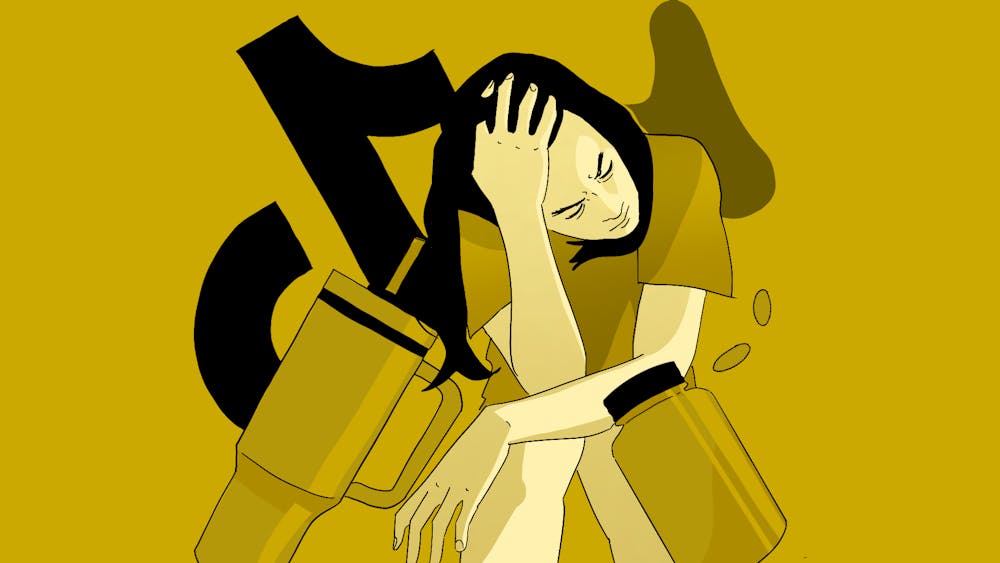People’s self–care routines have gone too far. What started as a path to well–being has transformed into a performative, punishing pursuit of perfection—one that ultimately defeats its own purpose. The “before my kids wake up” videos now read less like wholesome content and more like the intro of American Psycho. While these routines may be framed as wellness, they have a disturbing edge defined by precision, vanity, and ritual (which isn’t dissimilar from Patrick Bateman’s narrated morning routine).
Once upon a time, self–care was a form of physical and mental rejuvenation: A search for peace. It definitely wasn’t a documentation of a 4:30 a.m. ice bath followed by a 17–step skincare routine and NAD+ injection all before breakfast. In the name of self–care, people are now burdened by the pressure to achieve unattainable perfection, becoming prisoners of their own insecurities. In fact, with mouth tape, nasal strips, and castor–oil packs overnight, many have begun to look like hostages in their slumber.
Also, these regimens to be a “clean girl” often look unhealthy. And frankly, some of them don’t seem that clean. For a chance at “youthful complexion,” people are willingly using beef tallow, salmon sperm, and more. These animal byproducts are not generally recommended by dermatologists nor are they FDA approved. And yet, they’re sold out—driven by virality rather than vetted science. Tallow is now being rebranded as “ancestral skincare,” part of a growing online subculture that romanticizes primal purity over clinical expertise.
But, alas, a wrinkle is scarier than a face smeared with snail slime (c’mon, anything for dewy skin).
It’s hard to not fall for these trends—they’re everywhere. And, these solutions, regardless of how crazy they are, seemingly solve every possible issue in achieving “flawlessness.” In the process of absorbing the seasonal self–care jargon, you inevitably learn about problems you never knew existed.
Really, the multi–step wellness routines are better characterized as problem finders than solvers. Instead of only focusing on skin–deep issues, the routines make you aware of new fixations—strawberry legs, milia, “tech neck.” The consumer wellness industry thrives off this cycle of not solving problems but convincing us we have more. Because once harmless and negligible, the newfound insecurities become seemingly unavoidable barriers of beauty. And for many, once they start, they can’t stop.
The pathological obsession with skincare has a name: dermorexia. While it’s not an actual medical diagnosis, it’s still a disordered and harmful approach to skincare. Often, as dermatologist Jaishree Sharad explains, this overreliance on skincare has adverse effects—physically and mentally. Acids and retinoids bought in pursuit of glass skin can often backfire, leading to stubborn breakouts. And, when dermorexia is not treated properly, it can snowball into other mental health issues including anxiety, depression, and OCD.
In reality, estheticians say skincare doesn’t need to be complicated. Rather, we’ve needlessly overthought them. As dermatologist Elyse Love points out, skincare hacks have become the new diet hacks, fueling a modern dysmorphia around how we think our skin should look. Caught up in instant and one–size–fits–all solutions, many people end up compromising both their skin and sense of self. People are no longer chasing health—they are chasing an illusion of flawlessness.
ELLE Magazine attributes much of the new complexity with skincare to its “wellness–ificiation.” Now, skincare isn’t just about taking care of your skin, but reducing cortisol, increasing cognition, and enhancing circadian rhythm. While the evolution of skincare has begun to prioritize inner balance over just appearance, the growing obsession with both external and internal wellness has created a paradox. As consumers navigate the overwhelming number of philosophies, rituals, and routines, the pursuit of well–being itself risks becoming exhausting, leading to “wellness burnout.”
The proliferation of wellness “quick fixes” on TikTok and Instagram can be disillusioning, deceiving people into believing that stress is something a product can solve.
Take a consumer feeling overwhelmed. They stumble on a serum promising emotional wellness and buy it, momentarily soothed—until the stress creeps back in. A doom–scroll later, a new fix appears: clearly, the answer was waking up at 6 a.m. for red light therapy. And so the cycle continues: consume more, self-care harder, still not enough.
Evidently, with the competitive nature of social media’s “more is better” wellness culture, the days of just cleanser, moisturizer, and SPF are behind us. A simple routine now feels like a myth buried beneath the flood of newly invented skin solutions. The pressure isn’t just about self–improvement anymore; it’s about keeping pace. Every wellness routine presents a new “must–have” or “holy grail,” suggesting that if you’re not adding it to your regimen, you’re falling behind. And ironically, the more “self–care” we consume, the less we seem to know ourselves. Routines become identity. Products become personality. The actual self gets lost in the shuffle. After all, who wants to be the only one with an imperfection everyone else supposedly cured with an overpriced serum? Beauty FOMO is real, and it’s relentless.
Of course, there’s nothing wrong with taking care of yourself. But, we’ve corrupted the term self–care. It’s not about just being well enough anymore, but perfectly optimizing yourself.
Maybe the answer isn’t a new serum, but a pause. A decision to stop seeking perfection and remember what self–care is actually supposed to be. And, when your routine leaves you in a cycle of feeling anxious, suffocated, and smelling faintly of beef fat, it’s time to call it unhealthy.

